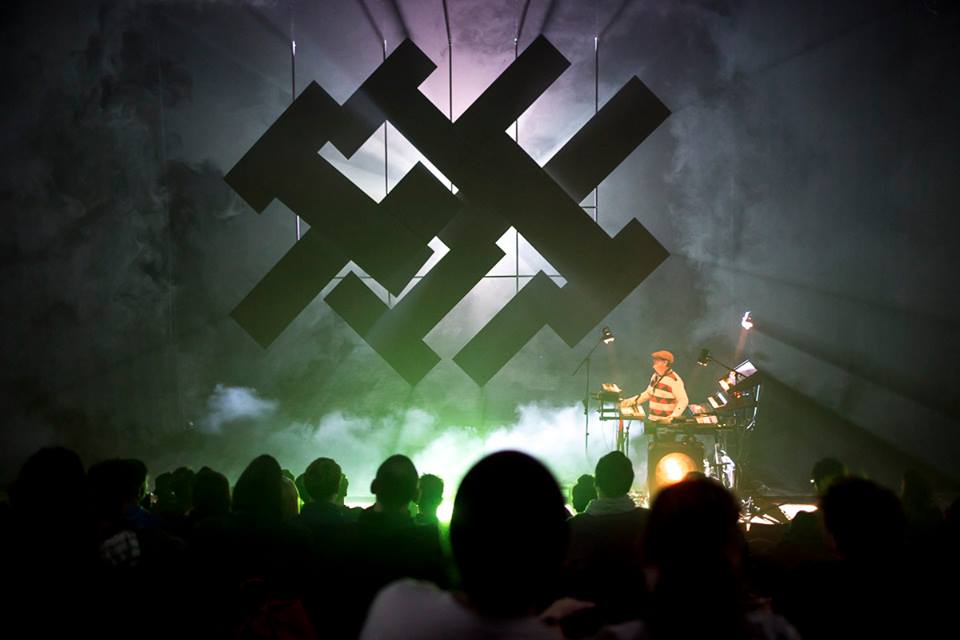Satori is an audiovisual performance project by Félicie d’Estienne d’Orves and Etienne Jaumet created in 2013. Félicie d’Estienne d’Orves lives and works in Paris. Through her videos, sculptures and projections, she has been researching the process of vision and its conditioning. Etienne Jaumet is a French musician, once the member of the outfit Zombie Zombie. We caught up with the audiovisual duo just before their hypnotising performance at the ICAS Festival in Dresden in May 2015.
You are just about to present your mutual project, SATORI, can you describe it?
Félicie d’Estienne d’Orves: It’s an audiovisual performance.
Etienne Jaumet: It’s a combination of live music and live manipulation of a sculpture – panels with lights behind them. It is about satori, which is a term that is very important in Buddhism.
FEO: It is a kind of awareness, a moment of meditation where your perception of life changes. It’s not like nirvana, it’s a new perception of life that remains. You are in front of this big frame that is motorised. It is an abstract show, Etienne is playing and we have this frame that is changing your perception of the theatre space. The 2D frame becomes 3D, with architectural beams of light. It’s a kind of abstraction like a Malevich painting in motion. We tried to describe this “Satori moment” without it being a self-meditation. The idea is quite simple, it’s only one frame describing the different perception of space and reality.
EG: It’s also a live performance, so each time, it’s quite different. I play the instruments live, nothing is pre-recorded. Everything is analogue. It’s also an interplay between the music and the movement of light.
Is the music improvised?
EG: There is a score with a timecode, and we tried to adapt our perception to find the right way of sensation. It’s quite an experience each time.
The score was written with the visuals in mind?
EG: It was written one year before. It was a ten-minute song that I made called “Satori”. We’d wanted to do something together for a long time, and when the opportunity arose, we were thinking what we could do together. We loved this idea of satori and tried to describe it with sound and light and we extended the song.
When you make your own respective art in this project, what sort of human senses are you trying to reach?
EG: Most of the time I try to lose the concept of time. I want to let my mind go with the score of lights. I want to alter the awareness of people, what they are hearing. I like it if people don’t exactly know what changed in the performance. Someone told me that with the 3D sculpture, they lost the sense of whether the sculpture was far or close. Sometimes they put their hand in front of their eyes to touch the ray of light because they lose the matter of space and distance.
FEO: It’s a project that plays with the boundaries of space. The space becomes abstract, without references. It’s an abstract illustration of the idea of satori. We are searching for a very physical perception. Etienne’s music in a way is trance music.
Can you talk about the visual side? How did you create these sculptures?
FEO: I was searching for geometries that allow me to do different steps. We have a big frame with fifteen smaller frames inside that recreate these different shapes. First it’s a rectangle, then it becomes these abstract but geometrical patterns. I was searching for a very simple shape, like a rectangle that can give a lot of geometry as well as a 3D space.
EG: The mapping is from the back, so you don’t perceive it as mapping per se. You feel the space.
FEO: My work as an artist – I do a lot of installations – is very physical in the end and you don’t really feel the technology behind it. The piece is instinctive rather than intellectual.
Have you collaborated before?
FEO: This was the first time, but I’ve been following Etienne’s music for a long time. I’m used to working with musicians who come from the electro-acoustic field. We were discussing a collaboration for 2, 3 years. I designed a piece of sculpture for his music specifically.
How did you do that?
FEO: We decided to work on a smaller piece, also called Satori, with a Japanese inspiration behind it. I listened to his first piece a lot and found something that illustrated the idea of satori. We were discussing every step – interested in the idea of total art – which would interlink music with the visuals. We worked on this together. Each piece of music has a rhythm. It’s a rotative sculpture.
EG: Satori, my record, was also done as a first take. It was a song that I made during one afternoon. Now I try to reproduce the feeling of that first take. Each time we do Satori together, it’s like a rebirth. I also like that people can perceive it in both active and passive way. They can walk around, or sit.
FEO: Satori is a transitory state. That’s why we are partitioning the light between the stage and the public. The sculpture is inspired by Japanese sliding doors called shōji which are partitioning Japanese houses. The sculpture is a partition between two worlds.
